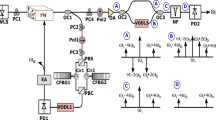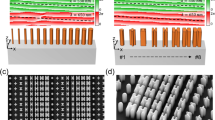Abstract
We present the principle of a fast liquid crystal end-less polarisation controller for first order polarisation mode dispersion compensation (pmd). We demonstrate how this device can be used as a variable and rotatable wave-plate and the resulting advantages to optimize the complexity of polarisation tracking algorithms. We give some experimental results obtained with an electro-clinic homeotropically aligned liquid crystal cell used as a variable and rotatable wave-plate. We discuss then the performance and the way to improve the device characteristics in order to meet the current operationalpmd compensation requirements.
Résumé
Cet article expose le principe d’un contrôleur de polarisation rapide, sans fin, pour la compensation dynamique de dispersion de mode de polarisation (pmd). On montre de quelle façon un tel composant peut-être utilisé comme une lame de phase variable à axe tournant, et les avantages qui en résultent pour l’optimisation des algorithmes de recherche de l’état de polarisation. On présente quelques résultats expérimentaux obtenus à partir d’une cellule à cristal liquide électrocline, alignée de manière homéotrope et utilisée comme lame de phase variable, à axe tournant. On discute ensuite les performances d’un tel composant et de quelle façon il est possible d’améliorer ses caractéristiques de manière à répondre aux spécifications exigées aujourd’hui par un système de compensation depmd.
Similar content being viewed by others
References
Karlsson (M.), “Polarisation mode dispersion mitigation-performance of various approa-ches”, Proc.OFC’02, p. 231–233, 2002.
Heisman (F.), “Polarisation mode dispersion: fundamentals and impact on optical communi-cation systems”, TutorialECOC’98,2, 1998.
Kaminov (I.P.) “Polarisation in optical fibre”Quantum Electronics,17, p. 15–22, 1981.
Francia (C.), Bruyère (F.), Thiéry (J.-P.), Penninckx (D.), “Simple dynamic polarisation mode dispersion compensator”Electronics Letters,35, no 5, p. 414–415, 1999.
Walker (N.G.), Walker (G.R.), Davidson (J.), “Endless polarisation control using an integrated optic LiNbO3”Electronics Letters,24, no 5, p. 265–268, 1988.
Walker (N.), Walker (G.), “Polarisation control for coherent communications”, JLT vol. 8, no 3, p. 438–458, 1990.
Rumbauch (S.), Jones (M.D.), Casperson (L.W.), “Polarisation control for coherent fibre optic systems using nematic liquid crystal” JLT vol. 8, no 3, p. 459–465, 1990.
Zhuang (Z.), Suh (S.W.), Patel (J.S.), “Polarisation controller using nematic liquid crystals”, Electronics Letters, Vol. 24, No 10, p. 694–696, 1999.
Chiba (T.), Ohtera (Y.), Kawakami (S.), “Polarisation stabiliser using liquid crystal rotatable wave-plates.” JLT Vol. 17, No 5, p. 885–890, 1990.
Shilizu (H.), Kaede (K.), “Endless polarisation controller using electro-optic wave-plate”,Electronics Letters,24, no 7, p. 412–413, 1988.
Heisman (F.), Whalen (M.S.), “Broadband reset-free automatic polarisation controller”,Electronics Letters,27, no 4, p. 377–379, 1991.
Hirabayashi (K.), Amano (C.), “Variable and rotatable waveplate of PLZT electro-optic ceramic material on planar waveguide circuits”IEEE Photonics Technology Letters,14, no 7, p. 956–959, 2002.
Dupont (L.), Le Gall (M.), De Bougrenet De La Tocnaye (J.-L.), Penninckx (D.), “Principle of polarisation mode dispersion controller using homeotropic electroclinic liquid crystal confined single mode fibre device”Optics Communications,176, p. 113–119, 2000.
De Bougrenet De La Tocnaye (J.-L.), Dupont (L.), “Complex amplitude modulation using liquid crystal spatial light modulators”, Applied Optics, vol. 36, p 1730–1741, 1997.
Dupont (L.), Sansoni (T.), De Bougrenet De La Tocnaye (J.-L.), “Endless smectic A liquid crystal polarisation controller”,Optics Communications,209, pp. 101–106, 2002.
Achaya (B.R.) et al. «Fast tunable in-line liquid crystal based polarization controller for reset free operation”, Post-deadline paper,pd2.8, Proc. ofECOC conference, Copenhague, September 2002.
Matsumoto (S.) et al., “Light processing and optical devices using nano-sized droplets of liquid crystal dispersed in polymer”,Journal of Intelligent Material Systems and Structures,10, no 6, pp489–492, 1999.
Author information
Authors and Affiliations
Rights and permissions
About this article
Cite this article
Dupont, L., de Bougrenet de la Tocnaye, J.L., Gadonna, M. et al. Fast liquid crystal end-less polarisation controller for first order PMD compensation. Ann. Télécommun. 58, 1364–1377 (2003). https://doi.org/10.1007/BF03001735
Received:
Accepted:
Issue Date:
DOI: https://doi.org/10.1007/BF03001735
Key words
- Optical fiber transmission
- Wave dispersion
- Light dispersion
- Wave polarization
- Optical polarization
- Signal convertor
- Liquid crystal device




